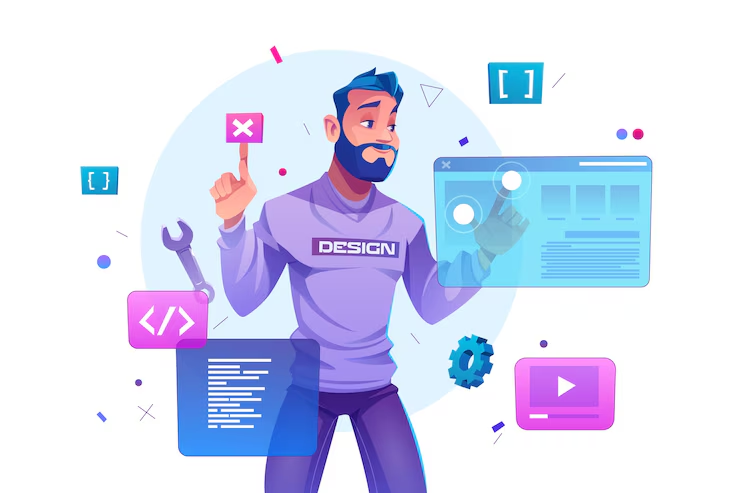What is a Frontend Developer?
A frontend developer is a web developer who specializes in the user-facing part of a website or application. They focus on the design, structure, and behavior of everything users interact with directly — from buttons, menus, and links, to more complex interactions such as animations, dynamic content, and forms.
The frontend developer primarily works with three core technologies: HTML (HyperText Markup Language), CSS (Cascading Style Sheets), and JavaScript. These technologies are the building blocks of web development and are fundamental to creating a website’s layout, style, and functionality.
Key Responsibilities of a Frontend Developer
The frontend developer is responsible for many tasks, including:
Designing and Developing User Interfaces: A significant part of the frontend developer’s job is to translate designs and wireframes into fully functional user interfaces. They ensure that the site or app is both visually appealing and user-friendly.
Writing Clean and Efficient Code: A frontend developer writes code that is both readable and efficient. This involves ensuring that the code adheres to best practices and coding standards while delivering a smooth user experience.
Optimizing for Performance: A key part of the frontend developer’s role is optimizing the website’s performance. This involves minimizing load times, optimizing images, and ensuring the website runs smoothly across different devices and screen sizes.
Ensuring Cross-Browser Compatibility: Frontend developers must ensure that their work works seamlessly on all major web browsers, such as Chrome, Firefox, Safari, and Edge, while also ensuring mobile responsiveness for different devices.
Collaborating with Designers and Backend Developers: Frontend developers work closely with UX/UI designers to implement design specifications, and with backend developers to ensure that the data flows seamlessly between the client-side and server-side of the application.
Core Skills of a Frontend Developer
To succeed as a frontend developer, mastering certain skills is essential. Here’s a rundown of the core competencies every frontend developer should have.
1. HTML (HyperText Markup Language)
HTML is the foundation of any web page. It provides the structure of the page and defines elements such as headings, paragraphs, links, forms, and images. Every frontend developer needs to have a strong grasp of HTML to create meaningful, semantic web pages. Understanding the role of HTML5 elements, including new tags for multimedia, forms, and embedded content, is essential for modern web development.
2. CSS (Cascading Style Sheets)
CSS is used to style the structure that HTML defines. It controls the visual appearance of the website, from colors and fonts to layouts and spacing. Frontend developers must be proficient in CSS to design beautiful and responsive user interfaces. Familiarity with CSS preprocessors like SASS or LESS can also be beneficial for enhancing the styling process.
Additionally, frontend developers must be well-versed in techniques like Flexbox, Grid layout, and responsive design principles to ensure that websites function well across all devices and screen sizes.
3. JavaScript
JavaScript is the programming language that allows frontend developers to make websites interactive. It is used to handle user interactions such as button clicks, form submissions, and page load events. Modern JavaScript frameworks like React, Angular, and Vue.js enable frontend developers to create highly dynamic web applications with reusable components and smooth user experiences.
A good frontend developer must be comfortable working with JavaScript, understanding concepts such as asynchronous programming, the DOM (Document Object Model), and event handling.
4. Version Control (Git)
Git is a version control system that helps frontend developers manage and track changes in their code. It allows developers to collaborate on projects, revert to previous versions, and maintain a history of code changes. Proficiency with Git and platforms like GitHub or GitLab is essential for modern web development teams.
5. Responsive Design
With the increasing use of mobile devices, frontend developers must ensure that websites are responsive and adapt to various screen sizes. Familiarity with responsive design techniques, such as media queries, is necessary to create mobile-friendly websites.
Frontend developers also use tools like Bootstrap and Foundation, which provide pre-built responsive grid systems and components, to speed up the design and development process.
6. Web Performance Optimization
Website speed is crucial for user experience and SEO rankings. Frontend developers must be skilled in optimizing web performance by minimizing file sizes, optimizing images, and employing techniques such as lazy loading and asynchronous data fetching. Tools like Google PageSpeed Insights and Lighthouse can help measure and improve website performance.
7. Knowledge of Web Accessibility
Ensuring that websites are accessible to all users, including those with disabilities, is a critical part of a frontend developer’s job. Understanding accessibility principles, such as using ARIA (Accessible Rich Internet Applications) roles and ensuring that the website is navigable via keyboard, is essential for creating inclusive web experiences.
8. Familiarity with Frameworks and Libraries
Modern web development involves using frameworks and libraries that simplify development and improve productivity. For example:
React.js is a popular JavaScript library used for building user interfaces.
Angular is a TypeScript-based framework for building dynamic web applications.
Vue.js is a progressive framework for building modern web interfaces.
Bootstrap is a front-end framework that provides pre-designed components and layouts.
Proficiency in one or more of these frameworks is highly valuable for a frontend developer.
Tools Every Frontend Developer Uses
In addition to core skills, there are a variety of tools that a frontend developer uses to streamline their workflow, improve code quality, and collaborate with team members.
1. Text Editors and IDEs
A frontend developer spends a lot of time writing code, so choosing the right text editor or Integrated Development Environment (IDE) is essential. Popular options include:
Visual Studio Code: A lightweight yet powerful code editor with extensions that support JavaScript, CSS, HTML, and many other languages.
Sublime Text: A fast and customizable text editor.
WebStorm: A feature-rich IDE designed specifically for JavaScript and frontend development.
2. Task Runners and Module Bundlers
Task runners and module bundlers automate repetitive tasks and help manage project dependencies. Popular tools include:
Webpack: A popular bundler for JavaScript, CSS, and HTML files.
Gulp: A task runner used for automating tasks such as minification, compilation, and file manipulation.
Parcel: A zero-config bundler that is easy to set up for smaller projects.
3. CSS Frameworks
CSS frameworks are pre-built collections of CSS, JavaScript, and UI components that can speed up the development process. Common frameworks include:
Bootstrap: A widely used front-end framework that includes pre-designed UI components.
Tailwind CSS: A utility-first CSS framework that gives developers more control over the design while speeding up development.
Foundation: Another responsive front-end framework that provides a set of flexible grid systems and UI components.
4. Browser Developer Tools
Browser developer tools are built into browsers like Chrome, Firefox, and Edge, allowing frontend developers to inspect, debug, and modify web pages in real-time. These tools are essential for troubleshooting layout issues, debugging JavaScript, and testing mobile responsiveness.
Career Path of a Frontend Developer
Entry-Level Frontend Developer
To start a career as a frontend developer, many individuals begin with an entry-level position, often after gaining a solid understanding of HTML, CSS, and JavaScript through formal education, coding boot camps, or self-study. At this stage, the focus is on learning how to implement basic UI designs, fix bugs, and collaborate with a team of developers and designers.
Mid-Level Frontend Developer
A mid-level frontend developer has gained experience in building web applications, using advanced JavaScript frameworks, and working with version control systems. They can take on more complex tasks such as integrating APIs, optimizing performance, and ensuring accessibility. They are also capable of mentoring junior developers and helping them with troubleshooting and problem-solving.
Senior Frontend Developer
A senior frontend developer is highly skilled in all aspects of frontend development. They lead projects, design complex user interfaces, and implement best practices. In addition to coding, they often take on leadership roles, collaborating with other teams and contributing to architectural decisions. They may also mentor junior and mid-level developers and stay up-to-date with emerging technologies and trends in frontend development.
Frontend Developer vs. Full Stack Developer
While a frontend developer focuses primarily on the user-facing aspects of an application, a full-stack developer is proficient in both frontend and backend development. Full-stack developers have a broader skill set, allowing them to build entire web applications from end to end. However, many frontend developers choose to specialize in the frontend to develop deeper expertise in user interfaces and client-side technologies.
The Future of Frontend Development
As the web continues to evolve, the role of the frontend developer will undoubtedly continue to change. Several emerging trends are shaping the future of frontend development:
1. WebAssembly (Wasm)
WebAssembly is a new standard that allows developers to run code written in languages like C, C++, and Rust directly in the browser. This opens up new possibilities for frontend developers to create high-performance applications that run efficiently on the web.
2. Progressive Web Apps (PWAs)
Progressive Web Apps combine the best features of web and mobile applications, offering offline capabilities, push notifications, and smooth performance. As more businesses adopt PWAs, frontend developers will need to learn how to build and optimize these types of applications.
3. AI and Automation
As artificial intelligence continues to advance, there will be opportunities for frontend developers to use AI and machine learning to create more personalized and intuitive user experiences. Automation tools may also take over some repetitive tasks, allowing developers to focus on more complex and creative aspects of frontend development.
4. Serverless Architecture
Serverless computing is an architecture that allows developers to build and deploy applications without managing servers. As serverless platforms like AWS Lambda and Azure Functions become more widespread, frontend developers will need to understand how to integrate these platforms with client-side code.
In conclusion, the role of a frontend developer is both challenging and rewarding. By mastering the core skills and tools, staying updated with the latest trends, and adapting to emerging technologies, frontend developers will continue to create exceptional user experiences and drive the future of web development. Whether you are just starting or are looking to advance your career, there is always something new to learn in the dynamic field of frontend development.



